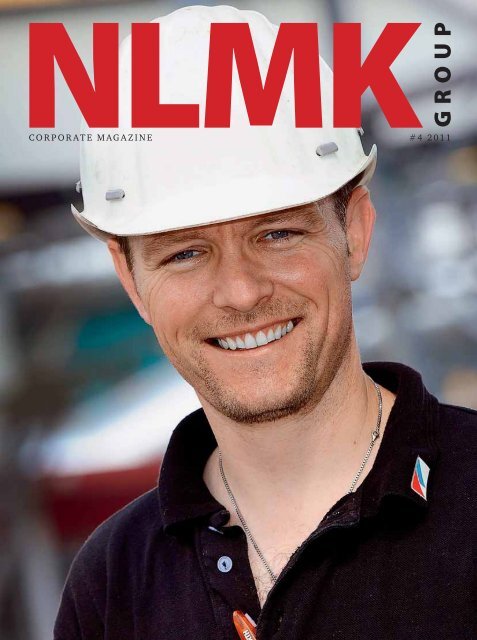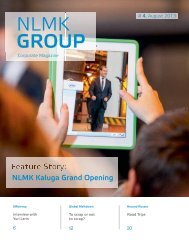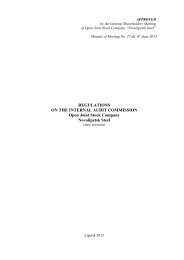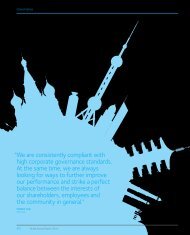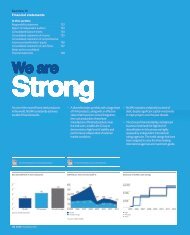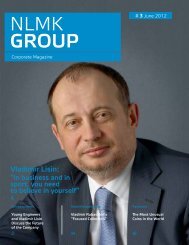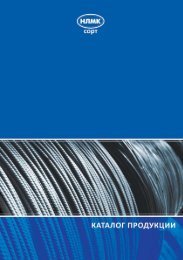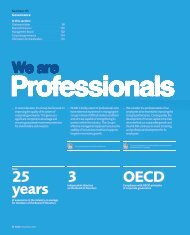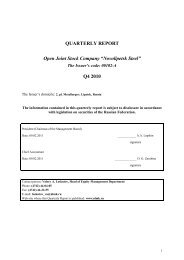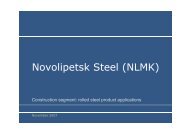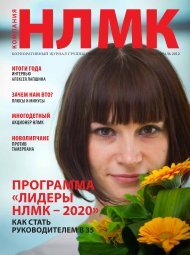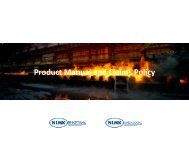You also want an ePaper? Increase the reach of your titles
YUMPU automatically turns print PDFs into web optimized ePapers that Google loves.
ROUP<br />
<strong>NLMK</strong>#4 CORPORATE MAGAZINE<br />
2011G
Business Promotes<br />
Bilateral Understanding<br />
T<br />
his year more than 300 guests gathered at the Chicago Cultural Center for the First Annual Russia<br />
Day hosted by the Chicago Sister Cities International. The event was made possible through the<br />
generous support of the US affiliates of several Russian companies, including <strong>NLMK</strong> Indiana. Some 20<br />
representatives of the Company took part in the celebrations.<br />
The event was attended by His Excellency Mr. Sergey Kislyak, Extraordinary and Plenipotentiary Ambassador<br />
of the Russian Federation to the United States.<br />
Mr. Alexander Tseitline, Vice President of <strong>NLMK</strong> Indiana, and Mr. Terry Laird, Director of Operations,<br />
participated in a round-table discussion with the Russian ambassador. The discussion focused on issues<br />
that impede the development of beneficial bilateral investments between Russia and the United States.<br />
And although <strong>NLMK</strong> <strong>Group</strong> itself serves as an example of very successful economic cooperation, there are a<br />
number of unresolved issues, like the delay with Russia’s accession to the WTO, the continued enforcement<br />
of the discriminatory Jackson-Vanik amendment, and difficulties with obtaining visas, which all hinder<br />
improvements in the investment climate for both countries.<br />
In his address, Ambassador Sergey Kislyak stressed that this was his first time celebrating Russia’s<br />
national holiday at an event which was being arranged by the American public rather than the Embassy<br />
itself. The Ambassador noted the dramatic changes in the Russian society over the last 20 years. A new<br />
and free generation has emerged in new Russia, a generation which has not been subjected to Communist<br />
indoctrination. Terry Laird also made a speech at the event. Later there was a small show with Russian folk,<br />
spiritual and classic music and dances. The audience greeted the performances with vivid interest. Apart<br />
from representatives of the business community and the general public, the event was also attended by<br />
clergymen of the Russian Orthodox Church.<br />
Everyone agreed that the celebration of Russia Day was a great success. Ms. Aleksandra Efimova, Co-chair of<br />
the Moscow Committee of Chicago Sister Cities International, expressed her hope that similar events would<br />
in time become an integral part of the political and cultural scene in Chicago, and would help to encourage<br />
better understanding between the people of Russia and the people of the United States, thereby promoting<br />
better relations between the two countries.<br />
FROM LEFT TO RIGHT:<br />
ALEXANDER TSEITLINE,<br />
<strong>NLMK</strong> INDIANA; PIOTR<br />
GALITZINE, TMK-IPSCO;<br />
SERGEY KISLYAK, RUSSIAN<br />
AMBASSADOR TO THE<br />
UNITED STATES; SERGEY<br />
KUZNETSOV, SEVERSTAL<br />
NORTH AMERICA
<strong>NLMK</strong> <strong>Group</strong> CONTENTS 1<br />
CALENDAR OF EVENTS<br />
Celebrating Metallurgist Day 2<br />
Presenting New Projects 6<br />
A place to come back to 6<br />
Ambassador from Luxemburg 7<br />
<strong>NLMK</strong> Rating Raised to Investment Grade 7<br />
<strong>NLMK</strong> Creates US and European Business Divisions 8<br />
ECONOMY AND PRODUCTION<br />
BF-7: The Pinnacle of Paul Wurth/<strong>NLMK</strong> Cooperation 9<br />
Young Leader is a Proud Name 13<br />
Automated Traffic Control 15<br />
Modernization Completed at SAL-7 15<br />
New Arrangements at the Open Pit 15<br />
Installing a New Mill 16<br />
A Machine for the Well 16<br />
PANORAMA<br />
The Tin Illusion 17<br />
The Streetcar Story 21
2 Calendar of Events CELEBRATION<br />
Celebrating Metallurgist Day<br />
Metallurgist Day is a major holiday in Russia’s industrial regions. This year in many communities where<br />
the Company operates this occasion was celebrated by everyone, combining it with City Day celebrations, and<br />
honoring steelworkers for the greatness and beauty of their work.<br />
LIPETSK<br />
CELEBRATING<br />
METALLURGIST DAY AND<br />
CITY DAY<br />
Business units at Novolipetsk<br />
held their traditional<br />
ceremonial meetings to celebrate<br />
top performing employees. The<br />
President of Russia awarded<br />
the Orders of Friendship to<br />
Anatoly Knyazev, Roller at the<br />
Cold-rolling and Coating Mill,<br />
Vladimir Karpachev, Etcher at the<br />
Grain-oriented Steel Operations,<br />
Alexander Tyulenev, Steel Caster<br />
at BOF Shop No. 1, and Nikolay<br />
Chebotarev, Operator at Blast<br />
Furnace Shop No. 1, in recognition<br />
of their contribution to the<br />
development of the metallurgical<br />
industry and many years of<br />
distinguished service.<br />
Eight Novolipetsk employees<br />
were awarded with medals of the<br />
Order of Meritorious Service to<br />
the Nation of the II degree, sixteen<br />
received the titles of Merited<br />
Metallurgist, Merited Machine-<br />
Builder, Merited Transportation<br />
Worker, Merited Chemical Industry<br />
Worker, and Merited Power<br />
Engineer of the Russian Federation.<br />
Andrey Yaroshenko, Director of<br />
Steelmaking Operations, received<br />
the Merited Service to the City of<br />
Lipetsk decoration. The photos of<br />
Ivan Plotnikov, Non-grain Oriented<br />
Steel Cutter, and Alexander<br />
Stolyarov, Senior Foreman at<br />
BOF Shop No.1, appeared on<br />
the updated Reputed Workers<br />
of Lipetsk picture gallery in<br />
recognition of their performance.<br />
In addition, by order of the Minister<br />
of Industry and Commerce another<br />
nineteen Novolipetsk employees<br />
were awarded the titles of<br />
Honorary Metallurgist, Honorary<br />
Machine-Builder, and Honorary
Calendar of Events CELEBRATION 3<br />
Chemical Industry Worker, and 42<br />
received letters of commendation<br />
and gratitude from the Ministry.<br />
Gold and silver Novolipetsk<br />
decorations were awarded to<br />
80 employees, one hundred<br />
employees were recognized as<br />
Veterans of Work, and 430 received<br />
certificates of honor and letters of
4<br />
Calendar of Events CELEBRATION<br />
VIZ-STAL.<br />
A SPORTS COMPETITION<br />
TO CELEBRATE<br />
METALLURGIST DAY<br />
CONCERT<br />
IN REVDA<br />
commendation from Novolipetsk<br />
management. All top performing<br />
employees were rewarded with<br />
cash bonuses. Everyone was in a<br />
great mood. There were concerts,<br />
and sports competitions, and all<br />
steelworkers and their families<br />
were invited to participate.<br />
Metallurgist Day celebrations<br />
were held in Revda, Nizhniye<br />
Sergi, and Berezovsky. More than<br />
300 employees from <strong>NLMK</strong> Long<br />
Products received sectoral, regional,<br />
municipal and corporate awards.<br />
Among others, rollers Leonid<br />
Podchinenov and Pyotr Dryagin<br />
were awarded the title of Honorary<br />
Metallurgist. There was great<br />
entertainment in store for the Urals<br />
steelworkers, including concerts,<br />
tournaments, competitions,<br />
contests, and shows by Russian<br />
celebrities. VIZ-Stal, another <strong>NLMK</strong><br />
company in the Urals, hosted<br />
competitions in professional skills,<br />
two-day sports tournaments in<br />
volleyball, indoor soccer, track and<br />
field, arm wrestling, and other<br />
events. Winners were awarded<br />
with certificates and cash prizes.<br />
VIZ-Stal employees and their<br />
families were presented with<br />
VIZ-STAL. TOP PERFORMERS RECEIVE AWARDS FROM CEO SERGEY<br />
MAKUROV AT A SPECIAL CEREMONY
Calendar of Events CELEBRATION 5<br />
tickets to a drama show staged<br />
by well-known actors Tatyana<br />
Vassilyeva and Efim Shifrin. On<br />
the eve of the holiday 96 VIZ-Stal<br />
employees were awarded sectoral,<br />
regional, municipal and corporate<br />
honorary certificates and letters of<br />
commendation.<br />
This year Zarinsk combined the<br />
Metallurgist Day and City Day<br />
celebrations for the first time.<br />
Altai-Koks and the City Council<br />
combined their efforts in preparing<br />
a great entertainment program.<br />
Shortly before the event, three<br />
company employees received great<br />
news – they had been awarded the<br />
titles of Merited Workers by the<br />
President of the Russian Federation.<br />
All in all 224 company employees<br />
received various awards. Photos of<br />
top performing workers were<br />
displayed in the Gallery of Honor,<br />
opened just before the holiday. A<br />
competition to improve site grounds<br />
was held at the plant, and winners<br />
were also announced during the<br />
Metallurgist Day celebrations. The<br />
winning teams were from Coking<br />
Shop No. 3, Automation Shop and<br />
Transport Shop. Sports<br />
competitions were kicked off by a 3<br />
kilometer foot race, which was won<br />
by Maksim Kuznetsov of Altai-Koks.<br />
The Top Five all-round competitions<br />
in strength gathered a large number<br />
of spectators. This entertaining<br />
event was won by the plant’s<br />
Firefighting and Rescue Team. The<br />
winners were awarded with<br />
certificates and cash prizes. The<br />
most active spectators were also<br />
awarded with presents. Festivities<br />
culminated in a grand concert in<br />
the square in front of the Metallurg<br />
Palace of Culture, with<br />
performances by popular bands<br />
Samotsvety and Chay Vdvoyom,<br />
followed by fireworks.<br />
ALTAI-KOKS EMPLOYEES<br />
WHOSE PHOTOS ARE<br />
DISPLAYED IN THE GALLERY<br />
OF HONOR<br />
METALLURGIST DAY<br />
IN ZARINSK. TOP FIVE<br />
COMPETITION EVENT
6<br />
Calendar of Events THE GROUP<br />
PRESENTING NEW PROJECTS<br />
<strong>NLMK</strong>’s Urals-based<br />
companies participated in the<br />
INNOPROM-2011 international<br />
exhibition in Yekaterinburg, where<br />
they presented new projects to<br />
develop their operations.<br />
Among other things, they<br />
demonstrated the ample<br />
capabilities of the Long Products<br />
Division to manufacture<br />
reinforcement bar stock, wire<br />
rod and metalware following the<br />
commissioning of the Rolling Mill<br />
in Berezovsky. The shop produces<br />
6 to 16 gauge reinforcement bars<br />
in bales and wire rod from 5.5 to<br />
22 millimeters in diameter using<br />
low carbon, high carbon and<br />
alloyed steel. Modern processes<br />
and technologies are capable of<br />
meeting future demand from the<br />
construction sector.<br />
VIZ-Stal presented its Technical<br />
Upgrade Program, which targets<br />
the production of high permeability<br />
steel, a completely new product in<br />
the Russian market, and enhanced<br />
competitiveness of standard steels.<br />
Both Russian and foreign power<br />
plant engineers have already<br />
expressed high opinions of laser<br />
treatment for electrical (grain<br />
oriented) steel, which helps to<br />
improve significantly the consumer<br />
properties of steel and to enhance<br />
the energy efficiency of transformers.<br />
Industrial scale production of high<br />
permeability steel (HPS) used in the<br />
manufacture of heavy-duty power<br />
transformers will further improve<br />
their energy efficiency. In Russia,<br />
the use of HPS in transformers can<br />
reduce power consumption by 2 to 3<br />
billion kilowatt-hours per year.<br />
The INNOPROM-2011 exhibition<br />
was also used by VIZ-Stal to<br />
showcase its investment projects on<br />
the introduction of energy saving<br />
processes and equipment for the<br />
manufacture of electrical steel.<br />
A PLACE TO COME BACK TO<br />
Mikhail Shmakov, President of<br />
the Federation of Independent<br />
Trade Unions of Russia (FNPR)<br />
visits <strong>NLMK</strong>'s production site in<br />
Lipetsk.<br />
He visited the mills, observed<br />
the operations, and talked to<br />
the personnel. Russia’s trade<br />
union leader acknowledged<br />
“<strong>NLMK</strong>’s solid approach to social<br />
responsibility and the active<br />
involvement of the Company’s<br />
trade union.”<br />
Mr Shmakov was immensely<br />
impressed by the new Blast<br />
Furnace #7 (BF-7) that will<br />
ensure a 40% output boost, and<br />
create 1164 jobs, including 268 at<br />
the facility itself. Pig iron will be<br />
produced with maximum<br />
automation, resource and<br />
environmental efficiency. “It [BF-7<br />
launch] is an event of great<br />
significance, and not just for<br />
Lipetsk, but for the whole of<br />
Russia, because it is more than just<br />
revamping and upgrades, it is<br />
about launching new steelmaking<br />
facilities,” Shmakov said. He was<br />
equally impressed with the Swan<br />
Lake (the plant’s little zoo), where<br />
he saw white peacocks for the first<br />
time in his life. “<strong>NLMK</strong> is one of<br />
the few companies you want to<br />
keep revisiting,” he said.
Calendar of Events THE GROUP 7<br />
AMBASSADOR<br />
FROM LUXEMBURG<br />
Gaston Stronck, Ambassador<br />
Extraordinary and Plenipotentiary<br />
of the Duchy of Luxemburg to the<br />
Russian Federation, paid a visit to<br />
Novolipetsk.<br />
The purpose of Mr. Stronck’s<br />
visit was to get an up close on<br />
the major investment projects<br />
undertaken by Novolipetsk as<br />
part of its Technical Upgrade<br />
Program. The key project of the<br />
program is the Blast Furnace<br />
No. 7, the first in modernday<br />
Russia, built by <strong>NLMK</strong><br />
in cooperation with Paul<br />
Wurth, a leading engineering<br />
company from Luxemburg. BF-<br />
7 was designed using the most<br />
advanced technological solutions.<br />
In fact, BF-7 incorporates all the<br />
best available technologies used<br />
in the construction and design of<br />
similar facilities.<br />
The blast furnace is currently<br />
undergoing pre-commissioning<br />
tests. Once it becomes operational<br />
it will allow <strong>NLMK</strong> to increase the<br />
output of pig iron by 3.4 mtpa and<br />
achieve a 40% increase in steel<br />
output. Mr. Gaston Stronck shared<br />
his impressions saying that<br />
“investing in modern technology is<br />
the best strategy for a producer<br />
who is truly concerned about the<br />
future. All of this will have<br />
a definite positive impact on<br />
the competitiveness of the<br />
company.”<br />
<strong>NLMK</strong> RATING RAISED TO<br />
INVESTMENT GRADE<br />
The international rating agency<br />
Moody’s has upgraded <strong>NLMK</strong>'s<br />
long-term credit rating from<br />
Ba1 to the investment grade<br />
level at Baa3. The outlook on the<br />
Company’s rating remains stable.<br />
Moody’s has highlighted the<br />
excellence of <strong>NLMK</strong>’s resilient<br />
business model, which has<br />
demonstrated sustainable<br />
operational and financial<br />
performance despite recent<br />
market downturn. Moody’s<br />
expects that <strong>NLMK</strong> will maintain<br />
its highly competitive production<br />
costs globally, benefiting from its<br />
efficient vertical integration into<br />
iron ore, coke and scrap. Moody’s<br />
has also noted the positive<br />
impact of <strong>NLMK</strong>’s acquisition<br />
of the rolling assets of SIF S.A.,<br />
its JV with Duferco <strong>Group</strong>, on<br />
earnings and the stability of its<br />
operations.<br />
Ms. Galina Aglyamova, <strong>NLMK</strong>’s<br />
CFO, commented: “We welcome<br />
<strong>NLMK</strong>’s credit rating upgrade by<br />
Moody’s. This is the third<br />
investment level credit rating to<br />
be awarded to our Company. This<br />
decision reflects the success of<br />
<strong>NLMK</strong>’s consistent efforts aimed<br />
at improving our financial<br />
position and the quality of<br />
business in line with our<br />
sustainable growth strategy.”<br />
FOR REFERENCE:<br />
<strong>NLMK</strong> has been ranked amongst five Russian private companies with<br />
investment grade status for several years. <strong>NLMK</strong> is the only company in the<br />
Russian steel sector with an investment grade rating from the three big<br />
rating agencies. The Company also has an investment grade rating of BBBwith<br />
a stable outlook from Standard and Poor’s and an investment grade<br />
rating of BBB- with a stable outlook from Fitch.
8<br />
Calendar of Events THE GROUP<br />
HORACIO MALFATTO,<br />
CEO OF <strong>NLMK</strong> EUROPE<br />
<strong>NLMK</strong> CREATES US<br />
AND EUROPEAN BUSINESS<br />
DIVISIONS<br />
<strong>NLMK</strong> has announced the creation<br />
of its new business divisions -<br />
<strong>NLMK</strong> Europe and <strong>NLMK</strong> USA,<br />
uniting all the <strong>Group</strong>’s foreign<br />
assets, including Steel Invest and<br />
Finance (formerly a joint venture<br />
between <strong>NLMK</strong> and Duferco<br />
<strong>Group</strong>), consolidated starting<br />
from July 1, 2011.<br />
<strong>NLMK</strong> has developed a new<br />
management structure for its<br />
international operations.<br />
Mr. Horacio Malfatto, formerly<br />
Chief Executive Officer of Steel<br />
Invest and Finance, has been<br />
appointed Chief Executive Officer<br />
of <strong>NLMK</strong> Europe. <strong>NLMK</strong> Europe<br />
Strip Products, a business unit<br />
combining European flat strip<br />
operations, will be headed by<br />
Mr. Ben de Vos, formerly a Director<br />
of La Louvière plant.<br />
Mr. Igor Sarkits, formerly<br />
a Director of DanSteel,<br />
has been appointed<br />
CEO of <strong>NLMK</strong> Europe<br />
Plate Products.<br />
Mr. Paul Fiore<br />
will continue<br />
as President<br />
& COO of all<br />
USA production<br />
companies.<br />
Mr. Robert Miller<br />
has been appointed<br />
to the position of<br />
President, <strong>NLMK</strong><br />
USA, responsible<br />
for strategic<br />
planning and<br />
procurement,<br />
finance, IT, sales<br />
and marketing.<br />
<strong>NLMK</strong> Europe is<br />
a manufacturer<br />
of innovative flat<br />
products combining<br />
all of <strong>NLMK</strong> <strong>Group</strong>’s<br />
European production<br />
and distribution<br />
facilities. The<br />
ROBERT MILLER,<br />
PRESIDENT OF <strong>NLMK</strong> USA<br />
division employs 3 000 people at<br />
six production sites specialized in<br />
hot rolling (including thick plates<br />
manufacturing), cold rolling and<br />
coating (galvanizing and prepainting)<br />
and a network of steel<br />
processing and distribution units in<br />
close proximity to the end users.<br />
<strong>NLMK</strong>’s industrial model is<br />
unique for Europe and is based<br />
on the efficient supply of semifinished<br />
products from Russia to<br />
flexible high quality European<br />
processing facilities, close to key<br />
customers. <strong>NLMK</strong> has successfully<br />
implemented this model at<br />
DanSteel, a Danish plate producer,<br />
where it has been applied since<br />
2002.<br />
<strong>NLMK</strong> Europe comprises two<br />
business units, Strip Products and<br />
Plate Products.<br />
Strip Products unit has an annual<br />
production capacity of 2.6 million<br />
tonnes at three production sites,<br />
<strong>NLMK</strong> La Louvière, <strong>NLMK</strong> Coating,<br />
<strong>NLMK</strong> Strasbourg, and a network of<br />
service centres. Plate Products unit<br />
has an annual production capacity<br />
of 1.93 million tonnes at three<br />
production sites, <strong>NLMK</strong> Clabecq,<br />
<strong>NLMK</strong> Verona, <strong>NLMK</strong> DanSteel.<br />
The synergies between the three<br />
facilities allow <strong>NLMK</strong> to offer its<br />
clients a full scope of products<br />
ranging from very thin/narrow to<br />
very thick/wide plates, as well as<br />
tool steel.<br />
<strong>NLMK</strong> USA has a diversified base<br />
of flat steel producing assets<br />
comprising three production<br />
sites at <strong>NLMK</strong> Indiana, <strong>NLMK</strong><br />
Pennsylvania (formerly, Duferco<br />
Farrell) and Sharon Coating,<br />
manufacturing slabs, hot-rolled,<br />
cold-rolled and galvanized<br />
products. It has an electric arc<br />
furnace (EAF) steelmaking<br />
capacity of approximately<br />
730,000 metric tonnes and hotrolling<br />
capacity of 2.7 million<br />
tonnes. The new division brings<br />
synergies through a common<br />
distribution structure offering a<br />
wide range of steel products to the<br />
construction, pipe and tubes and<br />
machinery sectors in the United<br />
States.<br />
The creation of new divisions was<br />
followed by the renaming of the<br />
entities previously forming part of<br />
Steel Invest and Finance.<br />
Former name<br />
New name<br />
<strong>NLMK</strong> Europe<br />
Strip Products<br />
Duferco La Louvière<br />
<strong>NLMK</strong> La Louvière<br />
Duferco Coating (Beautor)<br />
<strong>NLMK</strong> Coating<br />
Sorral<br />
<strong>NLMK</strong> Strasbourg<br />
Plate Products<br />
Duferco Clabecq<br />
<strong>NLMK</strong> Clabecq<br />
Dansteel<br />
<strong>NLMK</strong> Dansteel<br />
Verona Steel<br />
<strong>NLMK</strong> Verona<br />
Trading and service centers<br />
Duferco Transformation Europe<br />
<strong>NLMK</strong> Distribution France<br />
Duferco La Louvière Sales<br />
<strong>NLMK</strong> Sales Europe<br />
<strong>NLMK</strong> USA<br />
Duferco Farrell Corporation<br />
<strong>NLMK</strong> Pennsylvania<br />
Sharon Coating LLC<br />
Sharon Coating
9<br />
Economy and Production DEVELOPMENT<br />
BF-7: The Pinnacle of Paul<br />
Wurth/<strong>NLMK</strong> Cooperation<br />
Only a few days before Blast Furnace No. 7 goes on-line at <strong>NLMK</strong>’s Lipetsk site. Alexander Sutormin,<br />
Editor-in-Chief of the <strong>NLMK</strong> <strong>Group</strong> corporate magazine, interviewed representatives of Paul Wurth, the company<br />
that was the general designer and general contractor for the construction of BF-7. Steffen Koler is Senior<br />
Marketing Manager with the Paul Wurth Corporate Department, and Nicolas Mosel from the Sales and Project<br />
Implementation Department is the Project Manager for the construction of BF-7.<br />
STEFFEN KOLER,<br />
SENIOR MARKETING<br />
MANAGER, CORPORATE<br />
DEPARTMENT, PAUL WURTH<br />
Q: Gentlemen, why do<br />
you think <strong>NLMK</strong> chose<br />
your company to design<br />
and build BF-7? Do you<br />
have any past experience<br />
working with the Soviet<br />
Union or Russia?<br />
SK: We believe that the<br />
reason why our company<br />
was selected for this job<br />
is trust. <strong>NLMK</strong> blast furnace<br />
operators and engineers have<br />
trust in Paul Wurth technology,<br />
and in our experience with largescale<br />
internationally acclaimed<br />
projects. Paul Wurth began<br />
supplying technology to the Soviet<br />
Union in 1976. Ever since we have<br />
been continuously developing our<br />
cooperation with clients in Russia<br />
and the CIS. We believe that this<br />
market has great potential, it is<br />
one of the key markets for our<br />
international operations.<br />
A representative office of Paul<br />
Wurth has been active in Russia<br />
since 1992. In addition, in 2004<br />
we established a subsidiary, Paul<br />
Wurth Kovrov ZAO, which is a<br />
Russian corporation and is also<br />
involved in the BF-7 project.<br />
Q: Is BF-7 your first project<br />
with <strong>NLMK</strong> or have you had<br />
prior experience working with<br />
Novolipetsk steelmakers?<br />
SK: It was exactly at Novolipetsk<br />
that Paul Wurth launched its first<br />
project in the Soviet Union in 1976.<br />
It involved the delivery of the bellless<br />
top charging system for BF-6,<br />
launched in 1978. We are proud to<br />
have <strong>NLMK</strong> as our longest-standing<br />
client in your country!<br />
In 1995 we signed our first contract<br />
in modern-day Russia with <strong>NLMK</strong><br />
for the installation of a bell-less top<br />
charger at BF-5.<br />
Later we delivered automatic<br />
gas supply connector systems for<br />
blowing that ensure the safety of<br />
secondary steelmaking operations.<br />
These were used at <strong>NLMK</strong>’s BOF<br />
Shop No. 1 for the very first time<br />
in Russia. In addition, TMT, our<br />
subsidiary, supplied equipment for<br />
the cast house, and the measuring<br />
device and mathematical model for<br />
process improvement at BF-5. In a<br />
way, BF-7 is the culmination of our<br />
long-term productive cooperation.<br />
Q: It has been opined that<br />
Russian business owners<br />
are reluctant to invest in<br />
the modernization of their<br />
companies. Does this seem true<br />
to you?<br />
SK: I don’t see much of a difference<br />
compared to other countries.<br />
There will always be companies<br />
which practice a more responsible<br />
approach towards investments<br />
in developing their business, and<br />
there will be those which invest<br />
less. <strong>NLMK</strong> is definitely one of the<br />
leaders, given its long-term upgrade<br />
and development programs.<br />
Comparing Russia to other parts<br />
of the world, starting from around<br />
2000 blast furnace capacity<br />
upgrade efforts in your country<br />
have been on par with Western<br />
Europe and exceed those in the<br />
United States.<br />
Q: What considerations were<br />
taken into account during<br />
the design of BF-7 and what<br />
is the concept underlying its<br />
construction? Did you face any<br />
challenges because of this and<br />
how did you overcome them?<br />
NM: BF-7 design is based on Paul<br />
Wurth’s modern technological ideas<br />
which have been tested successfully<br />
in several blast furnaces across<br />
the globe. The BF-7 concept was a<br />
collaborative effort; it encompasses<br />
all the special requirements from<br />
<strong>NLMK</strong>, the local environment, and<br />
applicable Russian Federation
экономика и производство РАЗВИТИЕ 15
11<br />
Economy and Production DEVELOPMENT<br />
NICOLAS MOSEL,<br />
PROJECT MANAGER FOR THE<br />
CONSTRUCTION OF BF-7<br />
standards, and incorporates best<br />
available technology solutions.<br />
Some challenges had to be resolved<br />
during the construction phase.<br />
The first challenge was to clearly<br />
define the responsibilities of<br />
<strong>NLMK</strong> and Paul Wurth in terms<br />
of the workload and deliveries.<br />
The second challenge was to<br />
select and apply a number of new<br />
technological solutions which had<br />
not been used before by <strong>NLMK</strong><br />
experts. For example, the closed<br />
water circuits which are used to<br />
cool the casing of the furnace. We<br />
are confident that the combination<br />
of new technology and existing<br />
operation and maintenance<br />
skills will result in very strong<br />
performance by BF-7.<br />
Q: What makes BF-7 distinct?<br />
Is it different from facilities<br />
used in the West, is it inferior or<br />
superior?<br />
SK: Blast Furnace No. 7 is the<br />
first furnace in the former Soviet<br />
countries designed by a foreign<br />
company. The Soviet blast furnace<br />
design has a long tradition and<br />
Paul Wurth had the opportunity<br />
to share experience with your<br />
engineers. We would like to stress<br />
that many ideas suggested by<br />
engineers from Lipetsk and Russia<br />
were incorporated into the design<br />
and construction of BF-7, making<br />
it truly a product of international<br />
cooperation.<br />
NM: Essentially, any blast furnace<br />
is unique, and is distinguished<br />
by a distinct combination of raw<br />
materials, the design philosophy<br />
and the expectations of the client.<br />
It is therefore very difficult to<br />
make comparisons between blast<br />
furnaces. But just by seeing this<br />
facility once you can tell that it is<br />
different in terms of scale. More<br />
importantly, BF-7 is equipped<br />
with all appropriate safety<br />
features, in full compliance with<br />
Russian requirements applicable<br />
to metallurgical operations. Many<br />
other metallurgical facilities dim in<br />
comparison to the size of BF-7 and<br />
the extent of modern technology it<br />
utilizes. <strong>NLMK</strong> can be truly proud<br />
of its new and modern facility. And<br />
Paul Wurth, in its turn, will take<br />
pride in it as one of its latest and<br />
most advanced designs.<br />
Q: Please tell us more about the<br />
various processes and equipment<br />
proposed by Paul Wurth for BF-7?<br />
How would <strong>NLMK</strong> benefit from<br />
their use?<br />
SK: Firstly, it is the design of the<br />
blast furnace. It is a free-standing<br />
furnace utilizing modern refractory<br />
and cooling solutions which include<br />
copper cooling plates and a thinwalled<br />
riser equipped with closedcircuit<br />
cooling systems, and a most<br />
advanced air supply system for<br />
cold air blasting. This will ensure<br />
high operability and a long service<br />
life. An up-to-date charge make<br />
up solution, bell-less top charging,<br />
pulverized coal injection, reliable<br />
hydraulic equipment at the foundry,<br />
multiple process data recorders<br />
and a top notch automation system<br />
employing mathematical models<br />
and the Sachem expert system will<br />
ensure BF’s sustained performance<br />
in line with expectations and<br />
contract requirements.<br />
Q: What will be the<br />
environmental impact of BF-7<br />
operations? Can you really say<br />
that you have done your best and<br />
have employed the most effective<br />
methods to minimize the<br />
blast furnace’s environmental<br />
footprint?<br />
NM: The project utilizes all the<br />
best available technology to<br />
protect the environment. Dry<br />
scrubbing of waste gases is<br />
performed in a high-efficiency<br />
tangential cyclone installation<br />
which is followed by wet<br />
scrubbing. This approach helps<br />
to reduce significantly the<br />
amount of dust collected during<br />
wet scrubbing. The dust which<br />
gets separated in the cyclone<br />
can be further processed at the<br />
sintering plant for further use<br />
in the blast furnace. This will<br />
reduce the amount of waste<br />
requiring recycling or disposal.<br />
The bell-less top charging system<br />
employs nitrogen for secondary<br />
pressure equalization, and<br />
this helps reduce atmospheric<br />
emissions of contaminated blast<br />
furnace gas. A silencer is used<br />
to reduce noise generated by the<br />
pressure equalization equipment<br />
to acceptable levels. The cast<br />
house air cleaning system was<br />
designed in such a way so as to<br />
provide a comfortable working<br />
environment. The use of blast<br />
furnace gas to generate electric
экономика и производство РАЗВИТИЕ<br />
17<br />
power is a distinctive feature<br />
of the environmentally friendly<br />
operation of the new facility.<br />
Q: Did Paul Wurth gain any new<br />
experience from the project?<br />
NM: Absolutely, we have gained<br />
and continue to gain new<br />
experience and expertise from the<br />
Lipetsk project. This is part and<br />
parcel of our business – one never<br />
stops learning while implementing<br />
a project. For example, compliance<br />
with the requirements imposed<br />
by Rostekhnadzor (Russian<br />
engineering regulator) was an<br />
important challenge for the Paul<br />
Wurth team, and is one of the<br />
lessons learned from this project.<br />
Q: What are your plans for<br />
further cooperation with <strong>NLMK</strong>?<br />
SK: We are currently building<br />
pulverized coal injection<br />
installations for blast furnaces Nos.<br />
3, 4, and 5. The same technology<br />
will later be installed at blast<br />
furnaces Nos. 6 and 7. We see<br />
potential for further upgrades of<br />
blast furnaces, coke chemical<br />
operations and sintering facilities.<br />
Some of our technology and<br />
solutions can obviously help the<br />
Lipetsk operation become more<br />
profitable, more energy efficient<br />
and environmentally safe than it<br />
currently is. In addition, once the<br />
new BF-7 facility is started up, a<br />
regular exchange of information<br />
will become the basis for expanding<br />
our cooperation even further.
13<br />
Economy and Production CONTESTS<br />
Young Leader<br />
is a Proud Name<br />
<strong>NLMK</strong> <strong>Group</strong> businesses have concluded the Young Leader<br />
contests, which aim to identify and support talented<br />
workers under 35 years of age and create an environment<br />
for their professional and career advancement.<br />
VIZ-STAL. YOUNG LEADER CONTEST. A CHALLENGE<br />
NOVOLIPETSK. ALEXANDER TRUNIN, WINNER OF THE YOUNG LEADER CONTEST<br />
NOVOLIPETSK. YOUNG<br />
LEADER CONTEST. FINALE<br />
At Novolipetsk the contest<br />
was timed to coincide with<br />
the 50th anniversary of the<br />
first manned space flight. Some<br />
737 contestants participated<br />
in the qualifying round, but<br />
only 12 of them made it to the<br />
final round, held at the Lipetsk<br />
Palace of Culture. They faced<br />
the challenge of displaying their<br />
debate skills and erudition and<br />
the ability to be a team player<br />
while maintaining their distinct<br />
individuality. In other words<br />
they had to prove that they are<br />
leader material in front of a huge<br />
audience of spectators and fans.<br />
Mr. Alexander Trunin, Deputy<br />
Division Chief and Head of<br />
Technology Management Office,<br />
faired best in the tests and won<br />
the contest. Second place went<br />
to Mr. Maksim Panarin, Unit<br />
Foreman at the Water Supply<br />
Shop, and Ms. Natalya Lipskaya,<br />
Programmer, was the third<br />
runner-up.<br />
Novolipetsk has been holding<br />
such contests since 2005, and<br />
since then more than 90 finalists<br />
have been included in the<br />
database of promising employees.<br />
VIZ-Stal was holding the<br />
contest for the second time<br />
and this may explain why the<br />
competition was so intense. The<br />
winner had to show great selfcontrol<br />
and ability to operate<br />
under pressure. Mr. Dmitry<br />
Ananyin, Process Automation<br />
Unit Foreman, was able to display<br />
these qualities and combine them<br />
with a wonderful sense of humor,<br />
winning first place. Second place<br />
went to Mr. Alexey Malyshev,
Economy and Production CONTESTS<br />
14<br />
VIZ-STAL.<br />
YOUNG LEADER CONTEST<br />
WINNERS (FROM LEFT TO<br />
RIGHT): ALEXEY MALYSHEV,<br />
DMITRY ANANYIN, VIKTOR<br />
SYCHEV, AND IVAN SINITSYN<br />
ALTAI-KOKS. YOUNG LEADER CONTEST. A CHALLENGE<br />
Electrolysis Operator , Gas Shop.<br />
Mr. Viktor Sychev, Electronics<br />
Engineer, and Mr. Ivan Sinitsyn,<br />
Heat Treater, Rolled Products and<br />
Pipes, shared third place.<br />
At Altai-Koks the audience<br />
held their breath to hear the<br />
name of the winner. It was Mr.<br />
Anton Bukin, Operator at the<br />
Coking Shop. Ms. Olesya Prosova,<br />
Personnel Training Engineer,<br />
won second place, and Mr. Alexey<br />
Chirkov, Traffic Controller at<br />
the Railway Shop, came third.<br />
Tatyana Kunina, an accountant,<br />
was awarded the Spectator’s<br />
Choice prize.<br />
And of course, there were no<br />
losers in this contest of<br />
intelligence, youth and energy.<br />
Every participant may be<br />
considered a winner, if only for<br />
daring to stand up to the<br />
challenge. The contestants have<br />
made new friends, enjoyed an<br />
exciting experience, and have<br />
proved to all that they can be<br />
leaders notwithstanding their<br />
young age.<br />
ALTAI-KOKS.<br />
WINNERS OF THE YOUNG<br />
LEADER CONTEST: OLESYA<br />
PROSOVA, ANTON BUKIN,<br />
AND ALEXEY CHIRKOV
15 Economy and Production TECHNICAL UPGRADES<br />
AUTOMATED TRAFFIC<br />
CONTROL<br />
Within the framework of its<br />
project to automate traffic<br />
control operations Stoilensky<br />
has successfully completed<br />
start-up and adjustment<br />
activities for the data collection<br />
and processing server. A total<br />
of 124 vehicles, from buses and<br />
passenger cars to specialized<br />
mining vehicles, have been<br />
equipped with on-board<br />
systems, including controllers,<br />
sensors, wiring, antennas and<br />
safety devices.<br />
All of this has allowed<br />
improving controls over<br />
vehicle operations through<br />
continuous monitoring<br />
of vehicle locations and<br />
movement, fuel consumption<br />
and proper use. After reviewing<br />
the data Stoilensky was able to<br />
reduce equipment down-time,<br />
lower maintenance costs and<br />
increase the effectiveness of its<br />
vehicle fleet operations. Unit<br />
consumption of diesel fuel was<br />
reduced by almost 9% compared<br />
to last year, and the savings<br />
covered half the cost of the<br />
project.<br />
Another 116 transportation<br />
and specialized vehicles are<br />
expected to be linked to the<br />
automated traffic control system<br />
in the near future.<br />
MODERNIZATION COMPLETED<br />
AT SAL-7<br />
VIZ-Stal completed comprehensive<br />
modernization of the SAL-7<br />
Straight Annealing Line. This will<br />
improve the consumer properties<br />
of steel products.<br />
The cost of the project<br />
was around RUR86 million<br />
(~$3 million; €2.1 million)<br />
and involved a complete<br />
refurbishment of the strip<br />
NEW ARRANGEMENTS<br />
AT THE OPEN PIT<br />
Construction work continues in<br />
the Stoilensky open pit on a new<br />
mining transportation system.<br />
The goal: to increase the scale of<br />
stripping operations.<br />
The plan is to construct a new<br />
railway station, Otvalnaya, at<br />
the western edge of the pit some<br />
40 meters above the existing<br />
Alexandrovka station. This will<br />
allow stockpiling more overburden<br />
without occupying additional<br />
space.<br />
The Otvalnaya station is already<br />
equipped with a railroad track.<br />
Overhead conductor wire supports<br />
are being installed and work is also<br />
under way on connector spans<br />
between Otvalnaya and<br />
Zapadnaya, and Otvalnaya and<br />
cooling and drawing system, the<br />
installation of a heat straightening<br />
roller, and the implementation of<br />
a system for on-stream measuring<br />
of the magnetic properties and<br />
features of electrical insulation<br />
coating.<br />
The final stage of the project<br />
was the installation of a new<br />
machine for applying electrical<br />
insulation (magnetoactive)<br />
coating, which will improve the<br />
dielectric properties of steel.<br />
Alexandrovka stations, and the<br />
access tracks to the tiers on the<br />
western dump. The new system<br />
also involves setting up a railway<br />
post at the +210m mark, to<br />
enhance the productivity of the<br />
mining transportation equipment.<br />
Its primary purpose will be to<br />
separate the traffic for the removal<br />
of the Strelitsa motor dumping site,<br />
which will be completely removed<br />
by rail.
Economy and Production TECHNICAL UPGRADES 16<br />
INSTALLING A NEW MILL<br />
Equipment installation for the new<br />
Reversing Cold Rolling Mill at VIZ-<br />
Stal is well under way. The mill<br />
will have a capacity of 75 ktpy and<br />
is intended to play an important<br />
role in the production of high<br />
permeability steel (HPS).<br />
UNDER ONE ROOF<br />
An important development has<br />
taken place at VIZ, where the<br />
metalware shop, including the<br />
cutting and stamping units, as<br />
well as the resistance welding and<br />
powder coating units have moved<br />
to the tub and sink shop.<br />
At its new location all the<br />
metalware equipment has<br />
already been installed and<br />
renovated, and a new powder<br />
coating line has been procured.<br />
A continued process was<br />
impossible at the original<br />
location: degreasing and<br />
The RUR1.4 billion (~$48.5<br />
million; €34.9 million) project is<br />
being implemented jointly with<br />
Andritz Sundwig (Germany). It is<br />
one of the major elements of the<br />
plant’s Technical Upgrade and<br />
Development Program. It will boost<br />
<strong>NLMK</strong> <strong>Group</strong>’s HPS capacity from<br />
60,000 tonnes, currently produced<br />
at the Lipetsk site, to 130,000<br />
tonnes. Most of the larger<br />
unitsof the new rolling facility<br />
have already been installed,<br />
including the stand, the<br />
decoiler, two reversible coiling<br />
machines, delivery lines and<br />
carts for loading and removing<br />
coils, and several smaller<br />
units. A team of eight<br />
experienced rolling-mill<br />
operators is being trained to<br />
operate the new equipment.<br />
welding were performed on the<br />
first floor, while the coating was<br />
applied on the second floor. Now<br />
the whole process is concentrated<br />
in one place, precluding downtime<br />
and transportation costs<br />
associated with the delivery of<br />
components from one shop to the<br />
other.<br />
A MACHINE<br />
FOR THE WELL<br />
High precision screw cutting<br />
lathe delivered to mechanical<br />
shop at Stoilensky’s drainage<br />
well.<br />
The lathe is designed to<br />
perform a variety of turning<br />
operations and to cut metric,<br />
inch and modular threads. The<br />
machine is capable of processing<br />
parts up to two meters in length<br />
at great speed and with good<br />
quality. The new machine will<br />
be operated by Ivan Shokov, an<br />
experienced turner who has<br />
devoted several decades to his<br />
profession.<br />
EXPANDING<br />
THE PRODUCT MIX<br />
Berezovsky begins manufacturing<br />
new products – # 14 and # 16<br />
coiled reinforcement bars in<br />
two different strength grades:<br />
the A400 hot-rolled bars and<br />
the A500C thermo mechanically<br />
treated bars.<br />
“This is a challenging shape<br />
and we had to resolve a number of<br />
issues in order to start producing it.<br />
The first batch has been shipped to<br />
the construction of Olympic venues<br />
in Sochi. There is strong demand<br />
in the market for coiled bars, and<br />
many businesses are equipped to<br />
handle coils,” said Evgeniy Gurban,<br />
Director of the Berezovsky Rolling<br />
Shop. Earlier the Company had<br />
launched the production of 6 to<br />
12 millimeter bars.<br />
NSMMZ is currently the only<br />
factory in Russia that reliably<br />
produces A500C TMT bars in coils<br />
in the 6 to 16 millimeter diameter<br />
range. In the future the business<br />
intends to produce the full product<br />
range in order to target a larger<br />
segment of consumers.
17<br />
Panorama FROM HISTORY<br />
The Tin Illusion<br />
What do a powerful Ancient Egypt pharaoh and a sophisticated Silver Age artist have in common? Or an<br />
ardent French revolutionary and a mystic symbolist writer from early 20th century Russia? The answer to these<br />
questions is most unexpected: they all loved toy soldiers.<br />
A TIN SOLDIER IN A MOLD<br />
AFTER CASTING<br />
For many people toy soldiers<br />
are a very serious thing. They<br />
devote all their passion to playing<br />
or collecting toy soldiers and are<br />
willing to pay a fortune for a good<br />
collection. At one point Nicholas I<br />
paid 150,000 guilders to the<br />
craftsmen of Nurnberg for a scaleddown<br />
copy of the Russian army!<br />
On the other hand, there<br />
is little doubt that through<br />
games humans acquire relevant<br />
experience. On an impromptu<br />
battlefield a certain part of the<br />
world magically unravels before<br />
your eyes as something quite<br />
simple and easy to understand.<br />
For example, Maurice, Prince of<br />
Orange, one of the founding fathers<br />
of the Netherlands army, would<br />
first practice any military action<br />
by playing toy soldiers with his<br />
military commanders.<br />
Today, when we mention toy<br />
soldiers, we usually have in mind<br />
figurines made of tin, not least<br />
because of the famous Hans<br />
Christian Andersen tale. However,<br />
toy soldiers weren’t always made<br />
of tin. In 2000 B.C. the children of<br />
Ancient Egyptian pharaohs played<br />
with soldier figurines made of gold,<br />
stone or clay. During the Middle<br />
Ages future knights were taught<br />
the basics of military craft with<br />
visual aids in the form of figurines
Panorama FROM HISTORY<br />
18<br />
THE BRITISH ROYAL HORSE ARTILLERY<br />
(MADE BETWEEN 1893 AND 1946); MUSÉE DE<br />
L'ARMÉE, PARIS<br />
TOY CHARIOT WITH<br />
TWO HORSES (WOOD,<br />
BRONZE), ANCIENT ROME,<br />
1-2 CENTURIES A.D.;<br />
THE BRITISH MUSEUM<br />
NAPOLEON AND HIS SON PLAYING WITH TOY SOLDIERS ON A MAP IN THE EMPEROR’S STUDY AT THE TUILERIES PALACE<br />
made of wood, which would depict<br />
in every detail the outfits and<br />
weaponry of one army or another.<br />
Precious metals were also used to<br />
make these teaching aids.<br />
Small-sized depictions of saints,<br />
things quite remote from the<br />
military realm, were the precursors<br />
of tin soldiers. The former adorned<br />
the headwear of European pilgrims<br />
on their journey to sacred places<br />
during the Middle Ages. Once the<br />
pilgrimage was completed the<br />
figurines would be given away<br />
to children. Craftsmen took note<br />
of the children’s delight with the<br />
figures of saints and began making<br />
tin animals, peasants and, later,<br />
soldiers. Nurnberg became the<br />
largest producer of tin figurines<br />
and its craftsmen were considered<br />
to be the best in Europe, and the<br />
city itself gained a close association<br />
with tin figurines. In Russia after<br />
Peter the Great shops that sold tin<br />
soldier figurines were referred<br />
to as ‘Nurnberg shops’. In the<br />
19th century a special ‘Nurnberg<br />
standard’ for toy soldiers was<br />
established, requiring an infantry<br />
soldier figurine without a hat to be<br />
32 millimeters tall, while a figurine<br />
of a mounted soldier had to be 44<br />
millimeters tall. The famous tin<br />
soldier from the tale by Andersen<br />
was made in accordance with the<br />
Nurnberg standard.<br />
Apart from Nurnberg, some<br />
French cities also maintained<br />
long traditions of making threedimensional<br />
figures from metals.<br />
By the 19th century French<br />
craftsmen had also developed a<br />
standard of their own, which was<br />
later adopted as the international<br />
standard. The ‘French standard’<br />
required figurines to be somewhat<br />
taller than those made in Nurnberg,<br />
with a height of 50 millimeters<br />
for an infantry toy soldier, and<br />
60 millimeters for a mounted toy<br />
figurine.<br />
In Russia there was no largescale<br />
production of tin figurines<br />
SMALL CANNON,<br />
A TOY OF THE KING OF ROME<br />
(SILVER, METAL),<br />
CIRCA 1815, MALMAISON<br />
TOY CANNON, OWNED BY<br />
NAPOLEON’S SON (STEEL,<br />
WOOD, IVORY); EARLY 19TH<br />
CENTURY; FONTAINEBLEAU<br />
MUSEUM<br />
PAVLOV TOY BATTERY, BY K. DANILOV
19<br />
Panorama FROM HISTORY<br />
TIN SOLDIER MADE<br />
IN MODERN TIMES.<br />
A MOUNTED KNIGHT<br />
OF THE 13TH CENTURY.<br />
TOY SOLDIER OWNED BY<br />
THE KING OF ROME;<br />
335 MILLIMETERS TALL;<br />
MUSÉE DE L'ARMÉE, PARIS<br />
before the Russian Revolution.<br />
But there were Russian collectors,<br />
known for their passionate love for<br />
military figurines. Their collections<br />
had thousands of pieces and were<br />
considered to be some of the largest<br />
in the world.<br />
Peter III, who was known for<br />
his admiration of the military<br />
traditions of the Prussian Army<br />
under Friedrich the Great, owned a<br />
very impressive collection. Striving<br />
to reform the Russian Army in<br />
line with the Prussian, Peter<br />
started to acquire toy soldiers<br />
for demonstration purposes.<br />
Eventually he managed to<br />
assemble an impressive collection<br />
of figurines made of tin, lead, clay<br />
and even three-dimensional figures<br />
made of cotton wool and held<br />
together with powdered sugar.<br />
Peter III’s hobby was inherited<br />
and continued with great<br />
enthusiasm by his son, Paul I, and<br />
then grandson, Nicholas I. Some<br />
of the most fascinating pieces in<br />
the collection of Paul I include tin<br />
cannons that are exact replicas of<br />
contemporary artillery guns and<br />
are capable of firing.<br />
Nicholas I significantly enriched<br />
the collection by commissioning the<br />
Heinrichsenns, leading Nurnberg<br />
TOY MAMELUKE, OWNED BY<br />
NAPOLEON’S SON; MUSÉE<br />
DE L'ARMÉE, PARIS<br />
SWEDISH INFANTRY ATTACK SET; MADE BY V. NUJDIN FOR THE SWEDISH ROYAL COLLECTORS SOCIETY<br />
craftsmen, to manufacture<br />
figurines of soldiers of the Russian<br />
army in 1854. The toy regiments<br />
of cuirassier guards, hussars,<br />
dragoons, and infantrymen, all<br />
60 millimeters tall, arrived<br />
in Russia during the reign of<br />
Alexander II.<br />
The interest in military<br />
figurines in Russia surged<br />
in the late 19th and early<br />
20th centuries. Almost every<br />
boy and even grown men in<br />
affluent families would have<br />
their own collections of<br />
toy soldiers. However, tin<br />
soldiers continued to be<br />
manufactured abroad only, and the<br />
prices remained high. Alexandre<br />
Benois, famous Russian artist, at<br />
the age of 8 a commander of several<br />
hundred toy soldiers, remembers:<br />
“When it came to tin soldiers, I had<br />
a special weakness for those that<br />
were more expensive and were<br />
something of an aristocracy. These<br />
were ‘round’ and ‘salient’ figurines,<br />
and the cavalry were mounted on<br />
their horses and for greater stability<br />
were equipped with a brad that<br />
would fit into a hole in the mount’s<br />
saddle. Once dismounted, these<br />
riders looked very amusing. All<br />
these domestic military types were
Panorama FROM HISTORY 20<br />
imported from abroad and were<br />
fairly expensive.”<br />
Alexandre Benois maintained<br />
his passion for tin miniatures<br />
throughout his life. After the<br />
Russian Revolution his collection<br />
became part of the toy collection at<br />
the Hermitage.<br />
It is common belief that playing<br />
with tin soldiers is an exclusively<br />
male pastime. Like many other<br />
stereotypes this one is also<br />
occasionally proven wrong. Lidiya<br />
Ivanova, the daughter of Russian<br />
Silver Age poet, writer, mystic and<br />
philosopher Vyacheslav Ivanov,<br />
grew up in an environment where<br />
the military theme, to put it mildly,<br />
was out of favor. Nevertheless, she<br />
claimed that her favorite pastime<br />
was playing with tin soldiers. For<br />
hours she would engage in ‘tabletop<br />
warfare’ with one of her father’s<br />
frequent guests, often distracting<br />
him from the purpose of his visits.<br />
The guest was none other than the<br />
prominent symbolist poet Andrey<br />
Bely.<br />
After World War II, in Russia<br />
as well as elsewhere in the<br />
world, tin figurines became an<br />
object for collecting or a means<br />
of recreating historical events.<br />
This latter sentiment towards tin<br />
figurines is shared by historians<br />
Mikhail Loshkovsky and Alexander<br />
Lyubimov, who in the Soviet<br />
Union have made a significant<br />
contribution to reviving the<br />
popularity of the military history<br />
miniatures, as the familiar tin<br />
soldiers are officially referred<br />
to in academic parlance. When<br />
delivering lectures about battles<br />
from Russian and foreign history<br />
Loshkovsky and Lyubimov<br />
would always accompany their<br />
presentations with demonstrations<br />
using tin figurines. Loshkovsky<br />
later demonstrated the same battles<br />
to the production crew of ‘War and<br />
Peace’ when they were preparing to<br />
film war scenes.<br />
The change in sentiment towards<br />
tin miniatures encourages the<br />
emergence of a large number of<br />
figurines other than of military<br />
denomination. In addition to<br />
warriors and military hardware<br />
modern-day craftsmen also create<br />
figurines of politicians, historical<br />
personalities, or use tin to depict<br />
household scenes. Paintings are<br />
often used as a source of imagery.<br />
In 2000 V. Nuzhdin, a Russian<br />
sculptor, made a figure of Emperor<br />
Alexander I based on his portrait<br />
from the Military Gallery of the<br />
Winter Palace, possibly the most<br />
famous portrait of the emperor on a<br />
horse. A. Mitelev, another Russian<br />
artist, used Kotseba’s painting of<br />
‘Suvorov Crossing the Panixerpass’<br />
to create the ‘Suvorov Crossing the<br />
Alps’ series.<br />
TIN SOLDIER MADE IN<br />
MODERN TIMES. A HORSE<br />
GUARDSMAN WEARING<br />
1855 UNIFORM.<br />
Sudden Death<br />
Just like real-life soldiers, their tin replicas can ‘die’ of causes other than battle. One of the<br />
worst things that can happen to them is the so called tin plague, i.e. the ability of tin to expand<br />
dramatically at temperatures below 13.2 degrees centigrade, when tin turns brittle and<br />
disintegrates. If a piece of tin which had been exposed to low temperatures touches another<br />
piece of tin which had been kept in a warm place, the latter would also get ‘infected’. And<br />
even though tin soldiers are only one third tin and are less susceptible to the tin plague, they<br />
should not be exposed to cold temperatures. A sharp fall in air temperature in the storerooms<br />
of the Suvorov Museum in Petersburg caused damage to very valuable collections of tin<br />
soldiers.
21<br />
Panorama AROUND THE WORLD<br />
The Streetcar Story<br />
Streetcars have been around for more than a century and a half, and have long become a part of our<br />
culture as well as a reliable means of travel.<br />
A HORSE-DRAWN TRAM<br />
IN LONDON IN THE 1890'S<br />
A HORSE-DRAWN<br />
STREETCAR IN SWEDEN IN<br />
THE LATE 19TH CENTURY<br />
The streetcar is the travelling<br />
companion of modern-day<br />
civilization which emerged with<br />
the development of large industrial<br />
centers. As they continued to grow,<br />
they exposed urbanites to horsedrawn<br />
wooden trams, cable cars<br />
running on tracks, and steampowered<br />
streetcars.<br />
It is no accident that streetcar<br />
systems became the symbols of<br />
many cities (e.g. the cable cars<br />
in San Francisco, the old electric<br />
trams in New Orleans, or the<br />
historic lines in Lisbon), and local<br />
authorities are making efforts to<br />
preserve them.<br />
The first horse-drawn trams,<br />
i.e. a variety of railroad where<br />
passenger cars were pulled along<br />
tracks by horses, appeared in 1828<br />
in Baltimore in the United States.<br />
But even they had predecessors: in<br />
the early 19th century, when steam<br />
engines were far from perfect and<br />
could not generate enough power,<br />
certain cargo was carried from<br />
one town to another by railroad on<br />
horse-drawn carriages. And long<br />
before steam engines, small trams<br />
drawn by all kinds of animals<br />
had been used in underground<br />
mining operations. The modern day<br />
streetcars are descendants of these<br />
trams.<br />
It is worth noting that the horsedrawn<br />
trams turned out to be a<br />
rather awkward means of travel in<br />
an urban environment. The tracks<br />
would project above the ground a<br />
good 15 centimeters, becoming a<br />
major nuisance for other traffic. It<br />
was only in 1852 that the French<br />
inventor Alphonse Loubat, living<br />
in New York, designed the grooved<br />
rail which could be recessed into<br />
the pavement and still prevent<br />
the wheels of the carriages from<br />
skipping off the tracks.<br />
Once the challenge of protruding<br />
tracks had been resolved there was<br />
no stopping the development of<br />
urban railroads. Streetcars were<br />
gaining greater popularity from<br />
Sydney in the East to Buenos Aires<br />
in the West.<br />
As the number of passengers<br />
increased, the design of the<br />
streetcars changed also. Formerly<br />
made of wood and resembling large<br />
carriages, from which they had<br />
descended, the streetcars began to<br />
“dress up” in steel. Eventually the<br />
streetcar became one of the most<br />
reliable means of transportation<br />
and modern full-metal cars can<br />
run for more than 40 years. Later<br />
the cars gained greater agility, as<br />
the first streetcars experienced<br />
difficulties with the handling of<br />
turns. The greatest remaining<br />
challenge was animals used to
Panorama AROUND THE WORLD 21<br />
pull the cars. Horses, sometimes<br />
replaced with mules, were very<br />
expensive: they would tire quickly,<br />
fall ill, disobey, soil the streets, and,<br />
finally, needed to be fed.<br />
There were some early attempts<br />
to run small steam engines in city<br />
streets, but these proved to be an<br />
inadequate solution in an urban<br />
environment.<br />
In the meantime several large<br />
European cities started to develop<br />
a system of streetcars driven<br />
by cables. The design of this<br />
system is fairly unsophisticated.<br />
A continuously moving cable<br />
driven by large reels is laid along<br />
the tracks, and the streetcar<br />
attaches itself to it using a ‘hook”<br />
of a special design. Once the car<br />
approaches a stop, the conductor<br />
would disengage the ‘hook’ and the<br />
streetcar would come to a halt.<br />
The first cable-car line was<br />
launched in London in 1840, but<br />
the cables available at the time<br />
proved to be unreliable, and were<br />
soon replaced with steam engines.<br />
The idea was then developed by<br />
the Americans. Their research<br />
helped to design a truly efficient<br />
cable system, which later crossed<br />
the ocean on a return journey. The<br />
longest cable-car lines were built<br />
in Glasgow and Edinburgh, in<br />
the northern part of the United<br />
Kingdom. Over time the cable-car<br />
system in Glasgow was converted<br />
into a cable-car metro.<br />
The first electric-powered<br />
streetcars appeared almost<br />
simultaneously in different parts<br />
of the world in the 1880s. In 1881<br />
the famous German engineer<br />
Ernst Werner von Siemens built an<br />
electric-powered streetcar line in<br />
a Berlin suburb; a similar line was<br />
inaugurated in London in 1883;<br />
and 1885 saw the first attempts<br />
to use electricity for powering<br />
streetcars in Baltimore.<br />
A major drawback of the first<br />
electric engines was that electricity<br />
was supplied via a third contact<br />
rail. One can easily imagine the<br />
hazard posed by a live bar of metal<br />
lying in the street in damp weather.<br />
The solution was supplied by<br />
THE 1879 BERLIN TRADE<br />
FAIR. THE WORLD’S FIRST<br />
ELECTRIC-POWERED<br />
RAILROAD BUILT BY<br />
SIEMENS<br />
STREETCARS IN PARIS,<br />
LATE 19TH CENTURY
23<br />
Panorama AROUND THE WORLD<br />
Streetcar Trivia<br />
The first passenger railway car<br />
began running in 1807 in Wales<br />
between Swansea and Mumbles.<br />
The car was drawn by horses,<br />
naturally.<br />
Streetcars powered by<br />
compressed air were running<br />
between Paris and its Nantes<br />
suburb from 1876. Unfortunately,<br />
the need to build large<br />
compressor stations to recharge<br />
the streetcars and the need to<br />
do this frequently doomed the<br />
pneumatic system to a quick end.<br />
The ‘7:40’ song so popular<br />
in Odessa describes a steam<br />
powered streetcar. At the end<br />
of the 19th century these were<br />
used to transport passengers in<br />
several cities, including Odessa,<br />
on account of being more<br />
environmentally friendly and less<br />
noisy than conventional steam<br />
engines.<br />
The first full-time electric<br />
streetcar line was built in 1879<br />
by the famous German inventor<br />
Ernst Werner von Siemens. It<br />
consisted of a small four-car<br />
train and a locomotive with a 3.5<br />
horse-power engine powered<br />
by 150 volts of current supplied<br />
THE SAN FRANCISCO<br />
CABLE CAR<br />
American engineer Frank Sprague,<br />
who invented the trolley pole, a<br />
device used to collect current from<br />
overhead wires. However, it soon<br />
became obvious that the pole was<br />
only good at slow speeds because<br />
once the speed increased above a<br />
certain threshold the pole would<br />
disconnect from the overhead wire.<br />
Several experiments with a variety<br />
of current collectors resulted in the<br />
design of the pantograph in 1895,<br />
which soon became a signature<br />
feature of every streetcar, including<br />
modern ones.<br />
The invention of the pantograph<br />
encouraged the proliferation of<br />
streetcars across the world during<br />
the first three decades of the 20th<br />
century. Huge multiple car trains<br />
(so called tram trains with the<br />
number of cars matching regular<br />
commuter trains) were navigating<br />
across Tokyo and Seoul, Paris and<br />
over a third rail. This first streetcar<br />
was used to carry visitors at the<br />
German Industrial Exhibition.
Panorama AROUND THE WORLD<br />
24<br />
Electric trams were first<br />
invented by the Russian scientist<br />
Fyodor Pirotsky. Back in 1876 he<br />
tested the method of delivering<br />
electric current by rail, and in 1880<br />
his electric engine was used to<br />
move a streetcar.<br />
The bodies of modern-day<br />
streetcars rest on special dualaxle<br />
turnable bogies. The gauge<br />
of the streetcar track is the same<br />
as for conventional railroad tracks,<br />
i.e. 1520 millimeters in Russia,<br />
and 1435 millimeters in Western<br />
Europe. The only exceptions<br />
are Dresden and Leipzig, where<br />
Mexico City, Odessa and Cairo.<br />
In the early 20th century<br />
streetcars were more than just an<br />
urban means of transportation.<br />
Their routes were quite extensive:<br />
they would travel from one<br />
end of the city to the other and<br />
even commute to the suburbs,<br />
or occasionally connect several<br />
large urban sprawls. Belgium<br />
still operates the Coast Tram,<br />
which runs the entire length of<br />
the Belgian North Sea coast. Its<br />
streetcars cover a distance of<br />
67 kilometers, 69 stops and 16<br />
cities in two and a half hours.<br />
It is noteworthy that in the<br />
middle of the previous century<br />
a similar system was used to<br />
connect Leningrad and the city of<br />
Lomonosov, standing 66 kilometers<br />
away on the Bay of Finland.<br />
Even today inter-city streetcar<br />
lines are not such a rare sight. In<br />
the Upper Silesia part of Poland a<br />
system of streetcars runs between<br />
14 cities. In Germany, a specialized<br />
streetcar out of Manheim carries<br />
passengers via Heidelberg to<br />
Weinheim. And the No. 10 route of<br />
the Basel streetcar system will take<br />
you to other cities in Switzerland<br />
and even to neighboring France.<br />
Still, today’s extra-long routes<br />
are either the legacy of the golden<br />
age of the street car era, or a<br />
revival of its past greatness. In the<br />
middle of the 1930s the expansion<br />
A STREETCAR IN MOSCOW,<br />
1917<br />
A STREETCAR IN KOLKATA<br />
the gauges are 1450 and 1458<br />
millimeters, respectively.<br />
Apart from passenger<br />
streetcars and those used for track<br />
repairs and maintenance there are<br />
many other varieties. For example,<br />
there are special washing trains,<br />
or cars used to clear snow off the<br />
tracks. In Germany, a vacuumcleaner<br />
streetcar is used to clean<br />
the tracks.
25 Panorama AROUND THE WORLD<br />
Streetcar Trivia<br />
A STREETCAR<br />
IN NEW ORLEANS<br />
A FUTURISTIC STREETCAR<br />
IN STRASBOURG<br />
A STREETCAR IN DUBLIN<br />
of streetcar lines in Europe and<br />
the US decelerated, and 20 years<br />
later even started to regress. As<br />
the population of cities continued<br />
to grow there was greater demand<br />
for high-speed underground trains<br />
and personal cars. From around<br />
the middle of the 1950s and for<br />
almost three decades operation of<br />
streetcars had almost ceased in the<br />
United States, Great Britain, France,<br />
Spain, South Africa, Turkey, and<br />
other countries. The consequences<br />
were immediate: greater street<br />
congestion, environmental impact,<br />
and costlier public transportation<br />
(it is more expensive to build a<br />
subway line that a streetcar line).<br />
Canada pioneered a revival in<br />
the use of streetcars, followed by<br />
European countries, and eventually<br />
the United States. All of a sudden it<br />
became evident that streetcars can<br />
be an efficient means of<br />
transportation, especially when<br />
combined with subway and train<br />
services. Historical routes were<br />
resumed in San Francisco, Lisbon,<br />
New Orleans, Baltimore and other<br />
places, where old-timer streetcars<br />
are running and have become a<br />
source of sizeable revenues for local<br />
governments and a point of cultural<br />
interest.<br />
The first graffiti to appear<br />
on streetcars were created by<br />
prominent artists in the 1920s in<br />
the provincial city of Vitebsk. The<br />
drawings were made by N. Tsetlin<br />
and M. Kogan, the founding<br />
fathers of supremacist art and<br />
companions of the famous artist<br />
Kazimir Malevich.<br />
SCENE FROM A STREETCAR NAMED DESIRE (1951)<br />
Apart from the title the word<br />
‘streetcar’ appears only four<br />
times in “A Streetcar Named<br />
Desire” by Tennessee Williams.<br />
The story involves one of the<br />
main characters arriving at her<br />
sister’s place in New Orleans<br />
on a streetcar going to Desire<br />
Street in the Afro-American<br />
neighborhood of the city. The<br />
play was published in 1947, and<br />
a year later the streetcar was<br />
replaced by a bus.


